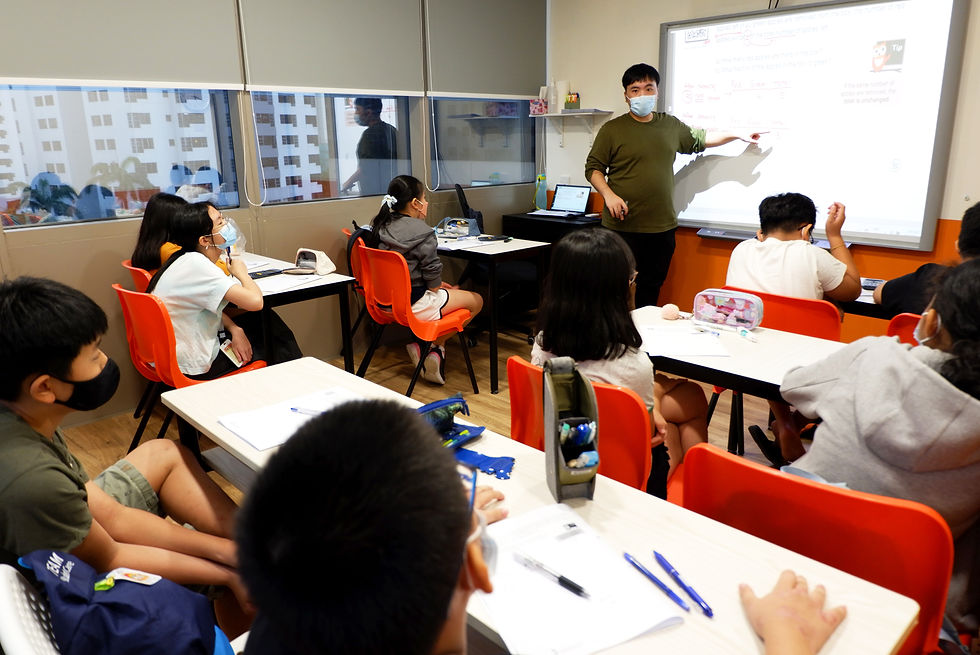5 Most Commonly Tested Math Problem Sums for Primary 4
- AGrader Learning Centre
- Mar 23, 2024
- 4 min read

Primary 4 mathematics introduces students to a range of problem sums, challenging their analytical and mathematical reasoning skills. These P4 math problem sums often encompass various concepts and problem-solving strategies, each designed to enhance students' mathematical proficiency. Understanding the type of problem sum and mastering the appropriate solving techniques are crucial for success in primary mathematics. Let's explore the most commonly tested problem sums for Primary 4 and delve into effective solving methods.
1. Comparison Model
A comparison bar model displays known and unknown quantities using solid bars, organised vertically, one below the other. This arrangement facilitates easy observation of differences in bar lengths, aiding students in solving the questions effectively.
Example Question:
Leon has a total of 2380 stamps. He has 566 more local stamps than foreign stamps. How many local stamps does he have?
Solution:
2 units = 2380 - 566
= 1814
1 unit = 1814 ÷ 2
= 907
907 + 566 = 1473
Leon has 1473 local stamps

2. Assumption Method
The assumption method, is also known as the supposition method.
The method is used when:
There are 2 types of items and each item has a value.
E.g. A car (item 1) has 4 wheels (value), while a bicycle (item 2) has 2 wheels (value).
Total value is given but exact number of each item is unknown.
E.g. There are 56 wheels in total. There are 16 cars and bicycles together.
Example Question:
There were 57 vans and motorcycles on the road. There were 138 wheels in total. What was the total number of vans present?
Solution:
Tip: If the question asks us to solve for vans, we assume the opposite (motorcycles).
Assuming all motorcycles,
57 × 2 = 114
138 – 114 = 24
4 – 2 = 2
24 ÷ 2 = 12
There were 12 vans.
3. Grouping Concept
Grouping concept problem sums involves grouping items together to make 1 group.
Then, find the number of such groups.
Look out for the proportion of one item to the other.
Take note that the items may have different values per unit.
Find the total value of 1 group first.
For some questions, you may need to find the lowest common multiple of 2 numbers.
.
Example Question:
A shop owner sold an equal number of cakes and drinks. What quantity of cakes was sold, given that each cake was priced at $4 and each drink at $3, resulting in a total collection of $84 by the shop owner?
Solution:
Find one group.
Group 1 cake and 1 drink.
$4 + $3 = $7
Find the number of groups.
$84 ÷ $7 = 12
1 group will have 1 cake and 1 drink.
12 groups will have 12 cakes and 12 drinks.
Hence, there were 12 cakes sold.

4. Stacking Model
Stacking models involve two or more items with multiple quantities of each item. These problems often require careful organization and calculation to determine the quantities or amounts involved. For example, “Kaylee bought 2 cups, 3 plates and 5 spoons.”
Example Question:
At a cinema, an adult ticket costs $6 more than a child ticket. Mr. Tan and his family bought 2 adult tickets and 4 children’s tickets for $54. How much does an adult ticket cost?
Solution:
Extra = $6 × 2
= $12
6 units = $54 – $12
= $42
1 unit = $42 ÷ 6
= $7
Adult ticket = $7 + $6
= $13
The adult ticket cost $13.
5. Equal Stage
Equal stage problem sums involve scenarios where two people or items have equal quantities at the beginning or the end. Drawing models and understanding keywords are essential for effectively solving the problem sums.
Here are some tips for equal stage problem sums:
Draw models of equal length when the two people/items have the same quantity.
Keywords like “gave away” means you should cut out from the model.
Keywords like “bought more” means you should add to the model.
For 2 equal fractions, we make the numerator the same.
Example Question:
In a carnival, 23 of the children tickets sold was equal to 1112 of the adult tickets sold. There were 108 more children tickets than adult tickets sold. How many children tickets were sold?
Children → 23 = 2233
Adults → 1112 = 2224
Children = 33 units
Adults = 24 units
33 units – 24 units = 9 units
9 units = 108
1 unit = 108 ÷ 9
= 12
33 units = 12 × 33
= 396
Understanding and mastering the various types of problem sum encountered in Primary 4 Mathematics is essential for students' success. With effective problem-solving strategies and practice, students can tackle math word problems confidently and excel in their mathematical journey. This problem sums guide for parents provides invaluable insights into helping students navigate through mathematical challenges, ensuring a solid foundation for future learning.

At AGrader, primary students are equipped with efficient techniques to solve 90% of challenging math problems swiftly. Our experienced tutors employ heuristics to teach problem-solving skills, enabling children to tackle even the most perplexing problem sums with ease.
Targeted at students from Primary 1 to 6, our tuition programme follows the latest syllabus outlined by the Ministry of Education in Singapore. The Primary Math Tuition Programme objectives include ensuring students develop a strong grasp of core mathematical concepts, applying these concepts through critical thinking and heuristics in problem-solving, and fostering confidence for school examinations.

Moreover, AGrader Learning Centre lessons are tailored to accommodate students of different proficiency levels. Emphasizing conceptual clarity and application-driven learning, students acquire the essential skills and knowledge essential for success in their mathematics assessments. With convenient accessibility across 19 locations throughout the island, parents have the flexibility to select the nearest centre, enabling effortless engagement in the programme.
Furthermore, the Primary Math Tuition Programme offers complimentary after-class support via the EverLoop Improvement System, which consists of five modules meticulously crafted to meet different student needs beyond the weekly lessons to improve further.
Join Our AGrader Community Today! (Free for all AGrader & Non-AGrader students)
Join our Telegram and WhatsApp channels to gain access to more study tips, free downloads, and much more for all subjects.
- WhatsApp channel: https://bit.ly/agwachannel
- Telegram channel: https://bit.ly/agtelchannel









Comments